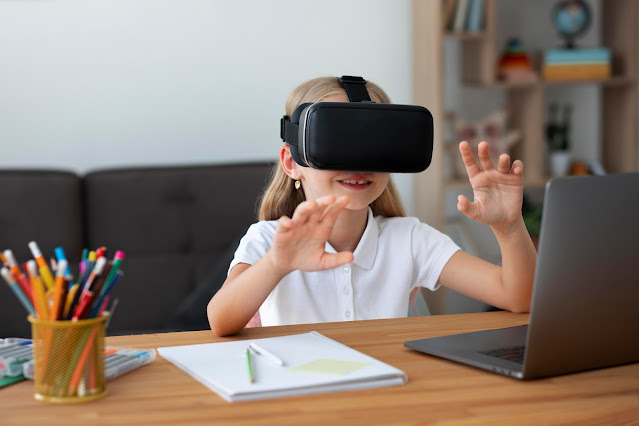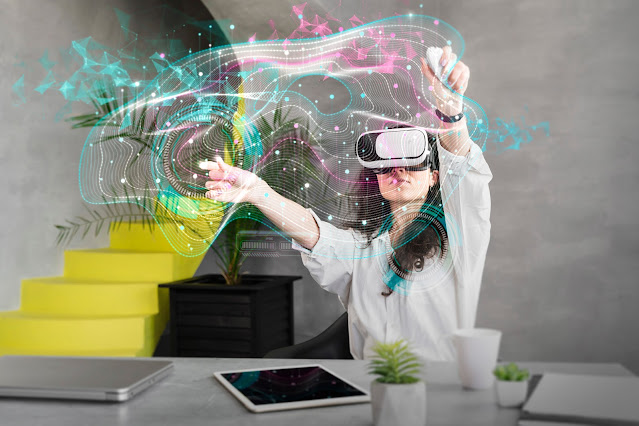Introduction: Virtual Reality (VR) is revolutionizing
education by providing immersive and interactive learning experiences. With its
potential to enhance comprehension, foster collaboration, and increase
accessibility, VR is shaping the future of learning. In this blog, we will explore
how VR is transforming education and discuss its key benefits.
Benefit 1: Virtual
Reality in Education
1. Enhanced Learning Experiences: Virtual reality offers
students realistic and engaging environments that go beyond traditional
teaching methods. By allowing students to explore historical landmarks, travel
to different countries, or simulate scientific experiments, VR provides
experiential learning that enhances comprehension and retention.
2. Active and Collaborative Learning: Through interactive
simulations and scenarios, VR promotes active learning by enabling students to
apply their knowledge and make decisions with immediate consequences.
Additionally, collaborative VR experiences foster teamwork and communication
skills, connecting students from different locations.
Benefit 2: Active
Learning
Virtual reality (VR)
has indeed experienced significant growth in the field of education,
particularly in the area of active learning. Active learning refers to an
instructional approach that engages students in hands-on activities, promoting
critical thinking, problem-solving, and collaboration. VR technology offers a unique
opportunity to enhance active learning experiences by creating immersive,
interactive, and dynamic virtual environments.
Here are some ways in
which VR is facilitating active learning in education:
1. Virtual Field Trips: Traditional field trips can be expensive,
time-consuming, and logistically challenging. VR allows students to visit
distant locations and experience realistic simulations without leaving the
classroom. Students can explore historical sites, museums, and natural wonders, or
even travel to outer space, gaining firsthand knowledge and a deeper
understanding of various subjects.
2. Accessibility and Inclusivity: Virtual reality
addresses accessibility challenges by providing adaptive learning experiences
tailored to individual needs. Students with physical disabilities can
participate equally, and remote learning ensures education reaches all
students, regardless of location.
3. Skill Development and Career Readiness: VR serves as a
powerful tool for developing practical skills and preparing students for future
careers. It offers hands-on training in fields such as healthcare, engineering,
and aviation, providing invaluable experience before entering professional environments.
4. Simulation-based
Learning: VR enables the
creation of realistic simulations for various disciplines, such as science,
engineering, medicine, and more. Students can perform virtual experiments,
practice surgical procedures, or simulate complex scenarios that would be
otherwise difficult or dangerous to replicate in a traditional classroom
setting. This hands-on experience enhances students' practical skills and
fosters a deeper comprehension of theoretical concepts.
5. Collaborative Learning: VR facilitates collaboration among students, even
when physically apart. Virtual classrooms and shared virtual spaces allow
students to interact, communicate, and work together on projects or
problem-solving activities. This collaborative environment encourages active
participation, teamwork, and social interaction, mirroring real-world
scenarios.
6. Personalized Learning: VR technology can adapt to individual student's
needs, providing personalized learning experiences. By tracking students'
actions and responses within the virtual environment, VR platforms can offer
tailored content, challenges, and feedback. This adaptive approach ensures that
students receive instruction at their own pace, promoting active engagement and
mastery of the subject matter.
7. Experiential Learning: VR enables students to engage in hands-on,
experiential learning by immersing them in realistic scenarios. For example,
language learners can practice conversations with virtual native speakers,
architecture students can design and explore virtual buildings, or history
students can relive significant events. This experiential approach enhances
active learning by stimulating multiple senses and creating memorable
experiences.
8. Accessibility and
Inclusivity: VR has the potential
to address accessibility barriers and provide equal learning opportunities for
students with disabilities. By offering customizable interfaces, adaptable
content, and multi-modal feedback, VR can cater to diverse learning styles and
accommodate individual needs. This inclusivity ensures that all students can
actively participate and benefit from immersive learning experiences.
Benefit 3: Skill Development
The rise of virtual
reality (VR) in education has brought about exciting opportunities for skill
development. VR technology provides immersive and interactive experiences that
can enhance learning in various fields and industries. Here are some ways in
which virtual reality is contributing to skill development in education:
By virtually visiting different cultures and
experiencing historical events, students develop a broader worldview and
cultivate tolerance and empathy.
1. Empathy and Cultural Understanding: VR experiences enable
students to step into the shoes of others, fostering empathy and cultural
understanding.
2. Simulation-based
training: VR enables students to
engage in realistic simulations that mimic real-world scenarios. This approach
is particularly valuable for developing skills in high-risk professions like
medicine, aviation, and engineering. For example, medical students can practice
complex surgical procedures in a virtual environment, allowing them to develop
critical skills before working on real patients.
3. Hands-on learning: Virtual reality allows students to participate in
hands-on learning experiences without the need for expensive equipment or
physical resources. For instance, in science education, students can explore
virtual laboratories, conduct experiments, and observe phenomena that would
otherwise be challenging to replicate in a traditional classroom setting.
4. Enhancing creativity
and design skills: VR tools offer a
platform for students to unleash their creativity and develop design skills.
They can create 3D models, sculpt virtual sculptures, design architectural
structures, or even develop virtual worlds. This promotes spatial awareness,
problem-solving, and artistic expression.
5. Language acquisition
and cultural immersion: VR can transport students to different parts of the
world, allowing them to immerse themselves in different languages and cultures.
Language learners can practice their speaking and listening skills in virtual
environments that simulate real-life conversations, providing a more authentic
learning experience.
6. Soft skills development: Virtual reality also plays a role in fostering the
development of soft skills such as communication, teamwork, and leadership.
Students can engage in virtual scenarios that require collaboration,
negotiation, and decision-making, allowing them to practice these skills in a
safe and controlled environment.
7. Accessibility and
inclusivity: VR has the potential
to make education more accessible and inclusive for students with disabilities.
It can create customized learning experiences tailored to individual needs and
provide alternative ways of engaging with educational content.
8. Career exploration: Virtual reality can offer students a glimpse into
various professions and industries. They can explore virtual job environments,
interact with professionals, and gain insights into different career paths.
This exposure helps students make informed decisions about their future and
develop the necessary skills for their chosen fields.
Overall, the rise of
virtual reality in education is revolutionizing skill development by providing
immersive, engaging, and interactive learning experiences. As technology
continues to advance, we can expect even more innovative applications of VR in
education and its impact on preparing students for the challenges of the
future.
Benefit 4: Empathy in Education
1. Experimentation and Risk-Free Learning: In certain
disciplines, VR allows students to conduct experiments and simulations in a
safe environment. This risk-free learning environment encourages exploration,
experimentation, and boosts student confidence and competence.
2. Personalized Learning and Data Analytics: VR platforms collect
data on student interactions and performance, allowing educators to personalize
instruction based on individual needs. Data analytics also enables tracking
progress and identifying areas where additional support is required.
Conclusion: Virtual reality in
education is poised to shape the future of learning. By enhancing learning
experiences, promoting active and collaborative learning, and fostering
empathy, VR opens up new possibilities for education. While challenges exist,
as technology advances and costs decrease, VR has the potential to become an
integral part of the educational landscape, transforming learning into a more
immersive, engaging, and effective experience.
Benefit 5: Future of
Learning
Virtual Reality (VR) has
indeed gained significant momentum in education and is shaping the future of
learning. The immersive and interactive nature of VR technology provides unique
opportunities to enhance traditional educational methods.
Here are some key
aspects highlighting the rise of virtual reality in education and its potential
future impact:
1. Immersive Learning
Experiences: VR allows students to
be fully immersed in simulated environments, offering a sense of presence and
engagement. This immersion can be particularly beneficial for subjects that are
challenging to visualize or experience, such as historical events, scientific
phenomena, or complex abstract concepts.
2. Enhanced Engagement and
Retention: VR experiences
stimulate multiple senses, which enhances student engagement and improves
information retention. Studies have shown that VR-based learning experiences
can lead to better knowledge retention compared to traditional teaching
methods.
3. Active Learning and
Experiential Education: Virtual reality enables students to actively
participate and interact with virtual objects and scenarios. They can explore
historical sites, perform lab experiments, or simulate real-world situations.
This hands-on approach fosters experiential learning, problem-solving, and
critical thinking skills.
4. Access to Remote and
Inaccessible Learning Opportunities: VR can overcome the limitations of physical space and
resources. It enables students to access learning opportunities that may be
geographically distant or financially challenging to reach. For example,
students can virtually visit cultural landmarks, explore space, or travel
through time without leaving the classroom.
5. Personalized and
Adaptive Learning: VR technology can
adapt to individual student needs and learning styles. Virtual environments can
be customized to provide personalized learning experiences, catering to diverse
abilities, preferences, and paces of learning. This flexibility helps optimize
learning outcomes and promotes inclusivity.
6. Collaboration and
Social Learning: VR can facilitate
collaboration and social interactions among students, even in remote settings.
Multiplayer VR experiences allow students to work together, solve problems
collectively, and exchange ideas. This collaborative element nurtures teamwork,
communication skills, and a sense of community.
7. Skill Development for
Future Careers: As industries embrace
VR and augmented reality (AR), the demand for skilled professionals in these fields
is rising. Integrating VR into education equips students with technological
literacy, digital skills, and a competitive edge for future careers.
8. Challenges and
Considerations: While VR offers
immense potential, it also comes with challenges. High costs, technical
requirements, content development, and accessibility issues are some of the
barriers that need to be addressed. Additionally, ensuring the ethical and
responsible use of VR technology is crucial to safeguarding student well-being
and privacy.
Note: The suggested blog
outline incorporates keywords related to the topic for SEO purposes. However,
it is important to ensure the content flows naturally and provides value to the
readers, rather than solely focusing on keyword optimization.
Image Reference: https://www.freepik.com/
.jpg)




.jpg)


.jpg)









